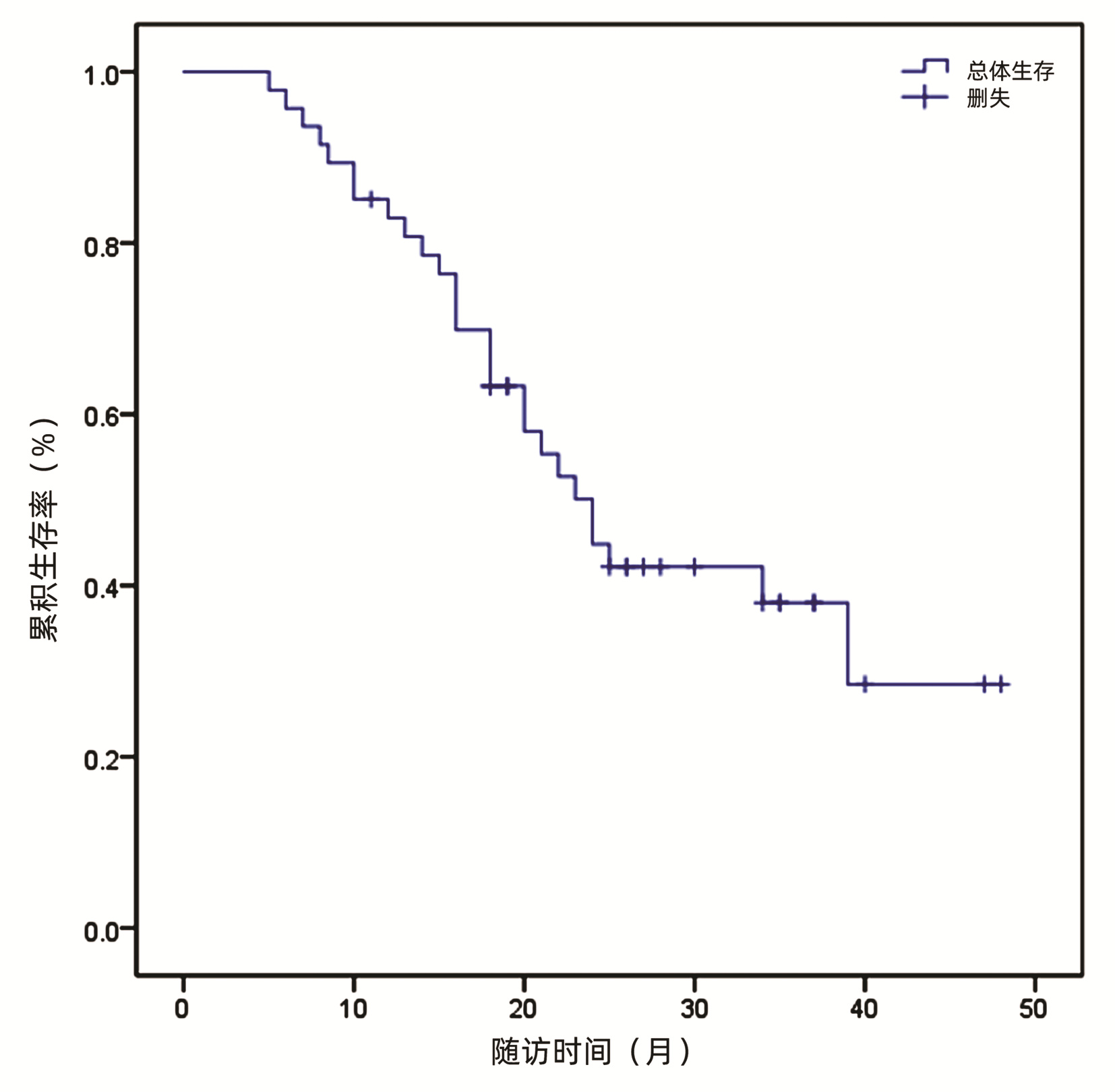|
[1] GE JB,XU YJ. Internal medicine[M]. 9th Ed. Beijing:People’s medical publishing house,2018.(in Chinese)葛均波,徐永健.内科学[M].第9版.北京:人民卫生出版社,2018.
|
|
[2] FERLAY J,SOERJOMATARAM I,DIKSHIT R,et al. Cancer incidence and mortality worldwide:Sources, methods and major patterns in GLOBOCAN 2012[J]. Int J Cancer,2015,136(5):e359-e386.
|
|
[3] ZHU XS,LIU WC. The progress in epidemiology and risk factors of primary liver cancer worldwide[J]. Mod Oncol,2008,26(14):2297-2301.(in Chinese)朱笑生,刘文超.原发性肝癌全球流行情况和危险因素的新进展[J].现代肿瘤医学,2018,26(14):2297-2301.
|
|
[4] ZHAO HT,ZHAI XF. The clinical progress on the treatment of primary liver cancer by chinese medicine compound preparations[J]. Chin J Tradit Chin Med,2017,23(17):107-110.(in Chinese)赵河通,翟笑枫.中药复方治疗原发性肝癌的临床研究进展[J].中医药导报,2017,23(17):107-110.
|
|
[5] LING CQ,YUE XQ,LING C. Three advantages of using traditional Chinese medicine to prevent and treat tumor[J]. J Integr Med,2014,12(4):331-335.
|
|
[6] ZHAO CQ,ZHOU Y,PING J,et al. Traditional Chinese medicine for treatment of liver diseases:Progress,challenges and opportunities[J]. J Integr Med,2014,12(5):401-408.
|
|
[7] FANG XF,ZHAO L,LYU YK. Experience of treating hepatocellular carcinoma with sini SAN[J]. Zhejiang J Integr Tradit Chin West Med,2010,20(7):414.(in Chinese)方晓芬,赵磊,吕宇克.周维顺应用四逆散加减治疗肝癌经验[J].浙江中西医结合杂志,2010,20(7):414.
|
|
[8] WANG W,YI LY,GAO JM. Effects of Sini Powder on transplanted hepatocarcinoma in nude mice Sirt1 and p53 expression[J]. Pharmocol Clin Chin Mater Med,2014,30(3):16-18.(in Chinese)王玮,伊莉雅,高健美.四逆散对HepG2移植性肝癌裸鼠Sirt1和p53表达的影响[J].中药药理与临床,2014,30(3):16-18.
|
|
[9] MORRIS GM,LIM-WILBY M. Molecular docking[J]. Methods Mol Biol,2008,443:365-382.
|
|
[10] LI KN,ZHENG HT,ZHANG Y,et al. Simulation and prediction of material foundation of Puerariae Radix for ischemic stroke based on molecular docking technology[J]. Chin Tradit Herb Drug,2008,49(8):1847-1853.(in Chinese)李克宁,郑惠婷,张雨,等.基于分子对接技术虚拟筛选葛根治疗缺血性脑卒中的物质基础研究[J].中草药,2018,49(8):1847-1853.
|
|
[11] XIAO Y,REN MD,LU GF,et al. The effects of saikosaponind on the expression of human hepatocellular carcinoma cell BECN1 and autophagic function[J]. J Xi’an Jiaotong Univ(Med Sci),2017,38(1):127-130.(in Chinese)肖祎,任牡丹,卢桂芳,等.柴胡皂甙d对人肝癌细胞BECN1表达及自噬功能的影响[J].西安交通大学学报(医学版),2017,38(1):127-130.
|
|
[12] WANG YL,SONG T,HU YN,et al. Effects of saikosaponins-d on Ang-2 and VEGF expressions in experimental hepatocarcinoma in rats[J]. J Xi’an Jiaotong Univ(Med Sci),2013,34(5):664-668.(in Chinese)王艳丽,宋涛,胡雅楠,等.柴胡皂甙d对实验性大鼠肝癌Ang-2及VEGF表达的影响[J].西安交通大学学报(医学版),2013,34(5):664-668.
|
|
[13] ZHANG FH,HUANG XS. Effect of radix bupleurae saponin D on in vitro differentiation of hepatocellular carcinoma cells[J].Guangdong Med,2009,30(12):1775-1777.(in Chinese)张丰华,黄秀深.柴胡皂甙D对肝癌细胞体外分化的影响[J].广东医学,2009,30(12):1775-1777.
|
|
[14] ZHANG J,JIANG TY,WANG SL. Application of prodrug design in improving anticancer drug properties[J]. World Clin Med,2007,28(1):47-51.(in Chinese)张婧,姜同英,王思玲.前药设计在改善抗癌药物特性中的应用[J].世界临床药物,2007,28(1):47-51.
|
|
[15] WANG BW. Structural based drug design for smal molecular stabilizers of p53 mutant Y220C[J/CD]. J Clin Med Literature(Electronic Edition),2007,4(103):20367-20369.(in Chinese)汪博闻.基于结构的p53突变体Y220C小分子稳定剂的药物设计[J/CD].临床医药文献电子杂志,2017,4(103):20367-20369.
|
|
[16] BAUER MR,JONES RN,TAREQUE RK,et al. A structureguided molecular chaperone approach for restoring the transcriptional activity of the p53 cancer mutant Y220C[J]. Future Med Chem,2019,11(19):2491-2504.
|
|
[17] XU Q,SUN Y,CHEN T,et al. A case study of sini SAN on the role of Chinese medicine in compound compounds[J]. Pharmocol Clin Chin Mater Med,2007,23(5):45.(in Chinese)徐强,孙洋,陈婷,等.以四逆散为例谈中药成分在复方中的作用地位[J].中药药理与临床,2007,23(5):45.
|
|
[18] HUANG DB,GUAN J. The improvement of TCM syndrome and prognosis of primary liver cancer treated with jiawei sinisan[J]. Nei Mongol J Tradit Chin Med,2008,37(6):1-2.(in Chinese)黄东彬,管静.四逆散加味治疗原发性肝癌的中医证候改善及预后分析[J].内蒙古中医药,2018,37(6):1-2.
|
|
[19] ZHAO LM. Effect observation of jiawei sini SAN in the treatment of primary liver cancer[J/CD]. J Cardiov Dis Integr Tradit Western Med,2016,4(29):149-151.(in Chinese)赵利孟.加味四逆散治疗原发性肝癌的效果观察[J/CD].中西医结合心血管病电子杂志,2016,4(29):149-151.
|
|
[20] LI ZQ. 25 cases of primary liver cancer pain treated by jiawei sini SAN[J/CD]. J Clin Chin Med,2014,26(8):788-789.(in Chinese)李自强.加味四逆散治疗原发性肝癌疼痛25例[J].中医药临床杂志,2014,26(8):788-789.
|
|
[21] ZHU G,LIU X,LI H,et al. Kaempferol inhibits proliferation,migration,and invasion of liver cancer HepG2 cells by downregulation of microRNA-21[J]. Int J Immunopathol Pharmacol,2018,32:2058738418814341.
|
|
[22] YOUNESS RA,ASSAL RA,EZZAT SM,et al. A methoxylated quercetin glycoside harnesses HCC tumor progression in a TP53/miR-15/miR-16 dependent manner[J]. Nat Prod Res,2018.[Online ahead of print]
|
|
[23] ZHANG XY. Relationship between changes in TP53,CTNNB1and CDKN2A genes and HBV infection associated hepatocellular carcinoma in fujian province[D]. Fuzhou:Fujian Medical University,2017.(in Chinese)张馨月.TP53、CTNNB1、CDKN2A基因改变与福建省HBV感染相关肝细胞癌的关系[D].福州:福建医科大学,2017.
|
|
[24] WEI YL,XIANG X,ZHAO LY,et al. Expression of HSP90AA1/HSPA8 in hepatocellular carcinoma patients with depression and its clinical significance[J]. China Cancer,2019,28(5):387-394.(in Chinese)韦珏伶,向骁,赵凌云,等.HSP90AA1/HSPA8在合并抑郁情绪的肝癌患者中的表达及临床意义[J].中国肿瘤,2019,28(5):387-394.
|
|
[25] XU QN,LU YF,TANG BZ,et al. Correlation between mRNA expression of heat shock protein in tumor tissue and tumor stage in patients with HBV-related hepatocellular carcinoma[J]. J Clin Hepatol,2017,33(5):869-874.(in Chinese)徐庆年,陆云飞,汤伯宗,等.HBV相关肝细胞癌肿瘤组织中热休克蛋白mRNA表达水平与肿瘤分期的相关性分析[J].临床肝胆病杂志,2017,33(5):869-874.
|
|
[26] HAN D,LI W,WANG Q. Expression and diagnostic value of serine/threonine kinase,Wnt2 pathway related proteins and c-myc gene in hepatocellular carcinoma[J]. Chin J Integr Tradit West Med Liver Dis,2016,26(3):173-175.(in Chinese)韩丹,李炜,王倩.丝氨酸/苏氨酸激酶、Wnt2通路相关蛋白及C-myc基因在肝癌中的表达及诊断价值[J].中西医结合肝病杂志,2016,26(3):173-175.
|
|
[27] CHEN WQ,CUI FQ,FAN CS,et al. Strategies of primary prevention of liver cancer in China:Expert Consensus(2018)[J]. China Oncol,2008,27(9):660-669.(in Chinese)陈万青,崔富强,樊春笋,等.中国肝癌一级预防专家共识(2018)[J].中国肿瘤,2018,27(9):660-669.
|
|
[28] FENG LN,JIN QL. Tenofovir can reduce the risk of hepatocellular carcinoma in patients with chronic HBV infection[J]. J Clin Hepatol,2020,36(2):463.(in Chinese)冯丽娜,金清龙.替诺福韦可降低慢性HBV感染者发生肝细胞癌的风险[J].临床肝胆病杂志,2020,36(2):463.
|
|
[29] LI WJ,TANG XP,JIANG FQ,et al. The clinicopathological significance of cyclin D1,Bcl-2,P53 and survivin in hepatitis C virus related hepatocellular carcinoma[J]. Prog Mod Biomed,2016,16(8):1439-1446.(in Chinese)李文娟,唐晓鹏,蒋芳清,等.CyclinD1,Bcl-2,P53和Survivin在丙型肝炎病毒相关肝细胞肝癌中临床病理意义[J].现代生物医学进展,2016,16(8):1439-1446.
|
|
[30] JIANG J,ZHANG Y,GUO Y,et al. MicroRNA-3127 promotes cell proliferation and tumorigenicity in hepatocellular carcinoma by disrupting of PI3K/AKT negative regulation[J].Oncotarget,2015,6(8):6359-6372.
|
|
[31] LIU PY. Regulation of quercetin on mitochondrial homeostasis and autophagy in hepatic steatosis and the mediating mechanism of Frataxin[D]. Wuhan:Huazhong University of Science and Technology,2018.(in Chinese)刘佩意.槲皮素对肝脂肪变性中线粒体稳态与自噬的调控及Frataxin的介导机制[D].武汉:华中科技大学,2018.
|
|
[32] WANG ZX,ZHOU J,TANG Y,et al. Quercetin induces P53-independent G2/M arrest and apoptosis in cancer cells[J]. Chin J Pharmacol Toxicol,2008,32(10):790-796.(in Chinese)王梓萱,周静,唐玥,等.槲皮素诱导肿瘤细胞P53非依赖的G2/M周期阻滞和凋亡[J].中国药理学与毒理学杂志,2018,32(10):790-796.
|
|
[33] ZHANG C,YANG LJ,LI J,et al. Radix paeoniae alba and radix bupleuri therapeutic mechanism for hepatocellular carcinoma based on network pharmacology[J]. Chin Arch Tradit Chin Med,2020,38(2):175-179,286.(in Chinese)张弛,杨良俊,李菁,等.基于网络药理学的白芍-柴胡药对治疗肝细胞癌的作用机制探析[J].中华中医药学刊,2020,38(2):175-179,286.
|









 下载:
下载:






 DownLoad:
DownLoad: